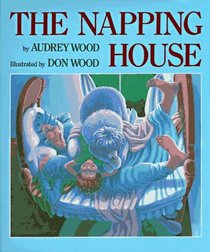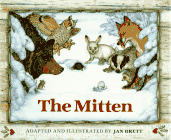The Napping House

by Audrey Wood. Illustrated by Don Wood. ![]() Picture Book. 32 pages. Grades PreK-2.
Picture Book. 32 pages. Grades PreK-2.
Find this book: Amazon

Teacher's Guide

This delightful cumulative tale has been a favorite with readers and listeners since its debut. It's a rainy afternoon and Granny is snoring on the bed in a cozy room. A child crawls on top of her and dreams. Gradually, the pile increases with a dozing dog, a snoozing cat, a slumbering mouse and finally a wakeful flea who, by biting the mouse, sets off a chain of events which results in a broken pile and even a broken bed. Each page repeats the action from bottom up.
The repeated phrases make Napping House ideal for beginning readers. Children with very limited attention spans also enjoy the complete restating of all the preceding action on each page.
(Continued Below)
Advertisement:

Things to Talk About and Notice
- Look at all the synonyms that you have for sleeping. Are there more? And what if it wasn't a napping house, but a laughing house? You'd have chucklers and grinners and??? Take one sentence from the book and change one word at a time, making sure each new sentence still makes sense: "There is a house, a napping house, where everybody's sleeping" becomes "Here is a house, a napping house, where everybody's sleeping", "Here was a house, etc.", until perhaps, "Here was a home, a laughing home, which has nobody crying". There are endless variations.
- Look at the illustrations now. Of course you noticed the changing colors as the house woke up. We start with a sleepy blue and change to a vibrant yellow as the afternoon rain changes to sunshine and a rainbow appears. Did you also notice that, except for the very first picture, everybody's there already in the room, long before the text takes notice of them. Watch the sleepers. Do any of them move before they get up to join the pig pile on the bed?
- Watch the changing perspective. At the beginning of the story, we're at eye level with the bed. As the pile goes higher, so does our vantage point until when the pile reaches its zenith, we must be on the ceiling. For children who have difficulty seeing this, focus their attention on the water pitcher; it's more apparent there.
- What about that bike left out in the rain? Is it Granny's or the child's or neither one?
- The concept that the flea was the straw that broke the camel's back could lead to other situations where that old saw seems to apply. Are there other books with a similar climax?

Activities
- It's an obvious step from this cumulative tale to all the others in song and story; songs such as "The Old Lady Who Swallowed a Fly", "The Hole in the Bottom of the Sea" and "There's a Hole in the Bucket" among countless others have been delighting singers and annoying listeners for years. The grandfather of the cumulative tales is probably "This Is the House That Jack Built".
- Sleepy people need lullabies and, when you've stopped singing cumulative songs, you can switch to lullabies. Use established ones and have the children rate them for relaxation potential. Take one favorite lullaby and rewrite it for a monster, a mouse, a crab.
- For mathematics activities you can count the critters, add more and keep counting. You have diminishing size. Can you put the sleepers in another setting? What diminishing sizes would you have in the ocean? a desert? a jungle?
- Brainstorm for synonyms for house and for names of houses used by other cultures. Then go for housely expressions such as "Any place you hang your hat is home" and "Home is where the heart is" and Dorothy's saving phrase, "There's no place like home." You can even get into changing roles in a household. Who does the housework in your house? Take a poll and graph the results, our money's on the mother.
- Notice the treehouse in the first picture. What if the action took place in the treehouse, would you have the same sleepers? Think of the quietest, most peaceful place you can think of: the place you'd go for escape and calm. Can you create a chain of events similar to this one? fishing, perhaps, with ever smaller fish on the line until it breaks? Switch the action to a haunted house. Now who are the sleepers? Make it a holiday book. Using a book like Napping House for plot inspiration can free up some writers who can't think of anything to write about.
- Rainy day activities other than sleeping can come next or hibernation or daytime versus nighttime sleepers. Pull it into the physical education program by building human pyramids and making pigpiles. By the way, what if the sleepers were on a trampoline instead of a bed?
- Whatever you do and wherever you go with the book, remember that you don't want to drain it of life by too many activites at once. Spread them out. Each activity is an excuse for rereading and, with each rereading, children can learn more about the conventions of print, just don't take out the joy.
(Continued Below)
Advertisement:

Related Books
- Bringing the Rain to Kapiti Plain ( Dial, 1981 ISBN 0-8037-0807-6) and Why Mosquitoes Buzz in People's Ears (Dial, 1978 ISBN 0-8037-6089-2), both by Verna Aardema.
- Look at Pat Hutchins' book The Doorbell Rang (Green-willow, 1986 ISBN 0-688-05252-5). Is this the opposite of The Napping House in any way?
 It's a natural step into other house books. A House Is a House For Me by Mary Ann Hoberman (Penguin, 1982 ISBN 0-14-050394) is the first one that occurred to us, but there are many others: "The Fisherman and His Wife", "Sleeping Beauty", "The Three Bears" and "Three Little Pigs" are the folk tales with housing in a central role that immediately come to mind. For other picture books we have The Village of Round and Square Houses by Ann Grifalconi (Little, 1986 ISBN 0-316-32862-6) and The Mitten (There are several versions of this old tale, but our favorite is the one by Jan Brett (Putnam, 1989 ISBN 0-399-21920-X).) By the way, isn't that another "straw that broke the camel's back book?"
It's a natural step into other house books. A House Is a House For Me by Mary Ann Hoberman (Penguin, 1982 ISBN 0-14-050394) is the first one that occurred to us, but there are many others: "The Fisherman and His Wife", "Sleeping Beauty", "The Three Bears" and "Three Little Pigs" are the folk tales with housing in a central role that immediately come to mind. For other picture books we have The Village of Round and Square Houses by Ann Grifalconi (Little, 1986 ISBN 0-316-32862-6) and The Mitten (There are several versions of this old tale, but our favorite is the one by Jan Brett (Putnam, 1989 ISBN 0-399-21920-X).) By the way, isn't that another "straw that broke the camel's back book?"
- Look at the "cozy bed" in The Napping House. What makes it cozy? Look at other bed books. Again we have "The Three Bears" but we also have "The Princess and the Pea" and the delightful counting song, "Roll Over" which has been made into two books by that title, one by Mordecai Gerstein (Crown, 21984 ISBN 0-517-55209-4) and one by Merle Peek (Houghton, 1981 ISBN 0-395-29438-X). Raffi's big book of his version of the Weavers' song, "Goodnight Irene" belongs here as well. Brainstorm for different kinds of beds: trundle, crib, basinette, cradle, and four poster come immediately to mind.
(Continued Below)
Advertisement:

Related Areas Within Carol Hurst's Children's Literature Web Site
- Books for Emergent Readers, article
Math Month in the Library, article
Why Mosquitos Buzz in People's Ears, a related book.
Who Sank the Boat, a related book.
- One Monkey Too Many by Jackie French Koller. Book Review. Another counting book.
- Free Teacher's Guides: A listing of all our teacher's guides. Picture Books, Nonfiction and Fiction.

Related Areas Elsewhere on the Internet
Following these links will take you off our web site. You will have to use your back button to return or, bookmark our site now so you can return anytime.

